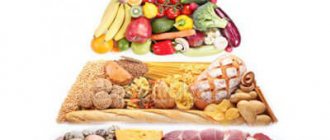Diet for pregnant women with diabetes mellitus: table No. 9, menu
Pregnancy is undoubtedly a happy time. It is very important for the expectant mother to lead a healthy lifestyle during this period and one of the main points is to eat right; not only her health, but also that of the unborn child depends on this. This is especially true for those women who had any chronic diseases before pregnancy. One of these diseases is diabetes mellitus.
be careful
According to WHO, every year 2 million people die from diabetes and its complications around the world. In the absence of qualified support for the body, diabetes leads to various kinds of complications, gradually destroying the human body.
The most common complications are: diabetic gangrene, nephropathy, retinopathy, trophic ulcers, hypoglycemia, ketoacidosis. Diabetes can also lead to the development of cancer. In almost all cases, a diabetic either dies fighting a painful disease or becomes a real disabled person.
What should people with diabetes do? The Endocrinological Research Center of the Russian Academy of Medical Sciences managed to create a remedy that completely cures diabetes mellitus.
Currently, the Federal program “Healthy Nation” is underway, within the framework of which every resident of the Russian Federation and the CIS is given this drug for 196 rubles. For detailed information, see the official website of the Ministry of Health.
Diabetes mellitus during pregnancy
In young women under 40 years of age, it is not often detected.
But there is a group of women who are predisposed to this disease. Diabetes mellitus may not manifest itself in any way, but worsen only during pregnancy.
There are true and gestational diabetes. Their difference is that true diabetes was already present in the woman before pregnancy, and gestational diabetes appears precisely during the period of bearing a child.
This may occur due to a malfunction of the pancreas. After all, all a woman’s organs work with increased load during this period.
After childbirth and recovery, as a rule, carbohydrate metabolism also normalizes. But the woman will still need to monitor her blood sugar with tests for some time.
The disease itself is dangerous because without treatment and control, it can lead to a diabetic coma.
Recommendations for young mothers after childbirth
When the birth is successful and gestational diabetes is no longer a concern, you should not relax. There is a high risk that you will soon develop type 2 diabetes. Gestational diabetes during pregnancy was a sign that tissue cells in your body have a poor response to insulin.
With age, tissue sensitivity to insulin increases, and the pancreas produces insulin in much smaller quantities. This contributes to the onset of diabetes and severe consequences associated with vascular complications. Women who have had gestational diabetes during pregnancy are at increased risk of developing these complications.
Take good care of your health and the health of your child, eat right!
The doctor's consultation
During pregnancy, it is important to promptly register with a doctor who will guide the woman through the birth.
The doctor will determine whether the patient is at risk. If necessary, he will send you for additional tests and examinations.
If diabetes is detected, the doctor will be required to prescribe a special diet, dietary table number 9. This is an important part of the healing stage.
Thanks to proper nutrition, blood sugar is reduced and normalized.
The course of the diet will depend on the complexity and severity of the disease.
If the patient is overweight during pregnancy, this may affect the weight of the child.
If the nutritional rules of Diet 9 are followed, the baby at birth will have a standard weight ranging from 2.8 kg to 4 kg.
And this is very important, because a woman with diabetes has a very high risk of giving birth to a large child weighing more than 4.5 kg.
The large weight of the child represents difficulty and danger during childbirth and can lead to injury to the child.
If the doctor sees upward deviations in the weight category, then the patient will be prescribed a diet plan for a long time, until the birth.
The optimal weight gain for a pregnant woman is no more than 10-12 kg.
General rules
Gestational diabetes mellitus is a disorder of carbohydrate metabolism associated with the onset of pregnancy . The critical period for its development is 24-28 weeks. This is explained by the fact that with increasing pregnancy, the level of counter-insulin hormones (partially blocking the action of insulin) hormones produced by the placenta increases, therefore, to maintain normal blood sugar levels, the secretion of insulin by the pancreas increases.
As the period increases, the need for insulin increases, as the placenta produces more hormones. This process is compensated by an increase in insulin production. Against the background of a sharp decrease in the activity of a pregnant woman, an increase in calorie intake, and weight gain, pronounced insulin resistance occurs (a decrease in tissue sensitivity to insulin). In the presence of factors - a hereditary predisposition to diabetes, obesity , insulin secretion is not enough to overcome insulin resistance. This leads to persistent hyperglycemia and diabetes mellitus in pregnant women is established.
Most often, it does not have the clinical manifestations characteristic of type 1 or 2 diabetes mellitus (thirst, frequent urination, itching, weight loss). Pregnant women have obesity and rapid weight gain, and only with high glycemic levels may characteristic complaints appear.
Elevated sugar during pregnancy, detected at least once, requires repeated examinations and observation by an endocrinologist. Stable maintenance of normoglycemia is the prevention of many complications during pregnancy.
- diabetic fetopathy;
- premature birth;
- asphyxia;
- fetal death;
- preeclampsia and eclampsia in the mother.
One of the characteristics of gestational diabetes is that it often goes unrecognized, so active identification of this disease among women with risk factors is important. In the group of low-risk women, stress testing with 75 g of oral glucose is not performed. The high-risk group includes women with severe obesity, diabetes in relatives, and carbohydrate metabolism disorders outside of pregnancy.
The diagnosis of diabetes in pregnant women is established if the glycemic : on an empty stomach exceed 5.37 mmol/l, 1 hour after a meal - 10 mmol/l, after 2 hours - 8.6, after 3 hours - 7.8 mmol/l. If more than 7 mmol/l is detected on an empty stomach, and more than 11 in a random study, as well as confirmation of these values every other day, the diagnosis is considered established and glucose loading tests are not required.
Treatment is aimed at achieving stable compensation of carbohydrate metabolism throughout pregnancy. At the first stage, a diet and dosed physical activity are prescribed.
The diet for gestational diabetes includes:
- Exclusion of simple carbohydrates (confectionery, honey, sugar, preserves, jams, sweets, sweet fruits and fruit juices, syrups, ice cream, sweet pastries, white bread).
- Complex carbohydrates (cereals, corn, potatoes, vegetables, fruits, pasta, legumes) should make up no more than 40-45% of daily calories. It is necessary to consume them evenly in 3 main and 3 additional meals. This eating pattern prevents starvation ketosis. Fasting is contraindicated.
- High protein content (1.5 g/kg weight).
- Enriching the diet with vitamins, fiber and minerals.
- Moderate restriction of fats, which serves as a prevention of weight gain.
- cholesterol intake .
- Eating potatoes because they are a high starch product.
- Pasta products.
- Boiled carrots and beets - they have a high glycemic index and cause a significant increase in glucose levels.
The diet will be characterized by a moderate decrease in energy value due to the limitation of simple carbohydrates and fats in the diet. However, protein, microelements and vitamins necessary for the full development of the fetus must be present in sufficient quantities. You should not limit your fluid intake unless contraindicated. Cooking should be steamed; baking or stewing is also used. When following a diet for a pregnant woman, it is important to control sugar levels 4 times a day (on an empty stomach and after main meals 1.5-2 hours later).
If, after following a diet for 2 weeks, normal glycemic values cannot be achieved, insulin therapy . Signs of macrosomia (large fetus) on ultrasound, the presence of diabetic fetopathy , increased insulin in the amniotic fluid also serve as indications for prescribing insulin therapy.
Oral hypoglycemic drugs are contraindicated for pregnant women, since they have a teratogenic effect and stimulate increased insulin secretion in the fetus. After childbirth, there is a possibility of normalization of sugar levels, but the diet should be followed for at least 2-3 months after childbirth. Some women may subsequently develop type II diabetes mellitus .
General principles of diet 9
Diet number 9 did not appear by chance. Developed back in Soviet times by a group of scientists from the Institute of Nutrition. It is aimed at treating and preventing the occurrence of the disease.
The main goal of the diet is to avoid intense weight gain for a pregnant woman and her unborn child, and to normalize carbohydrate, fat and protein metabolism.
The amount of carbohydrates should not exceed 250 grams per day. Fat is allowed up to 70 grams. On the contrary, the amount of protein is increased based on the woman’s weight.
Particularly important during this period for a woman are vitamins A, B, C, folic acid, vitamin D, and calcium.
It is known that there are carbohydrates that are easily digestible and those that are not digestible.
Carbohydrates, which are difficult to digest, are found in vegetables, some fruits, and berries. It is important to eat fruits with less sugar. Their advantage is that they create a feeling of satiety without raising blood sugar.
- First of all, sugar is eliminated. Also, do not consume products containing its substitutes. They can negatively affect the development of the fetus. Only taking fructose is considered completely safe for the child.
- Moderate use of salt in food is recommended. It is better to use sea salt, it is rich in iodine and other beneficial microelements.
- It is necessary to limit foods containing cholesterol. When preparing products, they must be boiled, baked or stewed, but not fried.
- For desserts, give preference to fruit salads.
The diet should be fractional, you need to eat in small portions, take it quite often, 5 times a day.
"Table 7"
Responsible for preventing edema and normalizing kidney function.
Nutrition according to this diet is based on reducing the intake of salt into a woman’s body (should not exceed 6 grams per day) and proteins, as a result of which blood flow and general condition improve.
The calorie content of food consumed is from 2200 to 3000 Kcal.
A prerequisite is to cook food without salt. It can only be added to ready-made dishes, depending on the norm. It is recommended to pre-boil fish and meat so that all excess salt goes into the broth. Food is steamed, boiled or baked. Food is taken in small portions 5-6 times a day.
List of prohibited products
- Quickly digestible carbohydrates: Confectionery products, flour.
- From fruits and vegetables: grapes, dates, beets and carrots, bananas and pears.
- Drinks: syrups, grape juice.
- From porridges: semolina and rice.
- Dairy: milk soups with cereals, sweet curds and cream.
- Broths and fatty meats. All kinds of canned food, sausages, salted and smoked fish, as well as caviar.
- Canned food, salty, spicy, sour.
- The sauces are spicy and salty.
Fully or partially limited products
The diet of pregnant women with gestational diabetes should not contain:
- sugar;
- candies, cakes, muffins and baked sweet products;
- honey, jam, syrups, jams;
- ice cream, heavy cream, yoghurts, curd mass, sweet curds;
- factory-produced fruit juices and nectars;
- carbonated fruit drinks;
- grapes, bananas, raisins, persimmons, melon, figs, dates, canned fruits and berries;
- smoked meats, sausages, lard, fatty smoked fish, canned food in oil, fatty broths;
- semolina and rice.
Products that should be limited in the diet:
- pasta;
- potato;
- animal fats, butter, sausages, fatty broths and fatty meats, smoked meats, fatty sauces, mayonnaise and cream.
Table of prohibited products
| Proteins, g | Fats, g | Carbohydrates, g | Calories, kcal | |
Vegetables and greens | ||||
| carrot | 1,3 | 0,1 | 6,9 | 32 |
| beet | 1,5 | 0,1 | 8,8 | 40 |
| horseradish | 3,2 | 0,4 | 10,5 | 56 |
Fruits | ||||
| apricots | 0,9 | 0,1 | 10,8 | 41 |
| pineapples | 0,4 | 0,2 | 10,6 | 49 |
| bananas | 1,5 | 0,2 | 21,8 | 95 |
| melon | 0,6 | 0,3 | 7,4 | 33 |
| mango | 0,5 | 0,3 | 11,5 | 67 |
Berries | ||||
| grape | 0,6 | 0,2 | 16,8 | 65 |
Nuts and dried fruits | ||||
| raisin | 2,9 | 0,6 | 66,0 | 264 |
| dried figs | 3,1 | 0,8 | 57,9 | 257 |
| dates | 2,5 | 0,5 | 69,2 | 274 |
Cereals and porridges | ||||
| semolina | 10,3 | 1,0 | 73,3 | 328 |
| rice | 6,7 | 0,7 | 78,9 | 344 |
| sago | 1,0 | 0,7 | 85,0 | 350 |
Flour and pasta | ||||
| pasta | 10,4 | 1,1 | 69,7 | 337 |
| noodles | 12,0 | 3,7 | 60,1 | 322 |
Bakery products | ||||
| wheat bread | 8,1 | 1,0 | 48,8 | 242 |
Confectionery | ||||
| jam | 0,3 | 0,2 | 63,0 | 263 |
| candies | 4,3 | 19,8 | 67,5 | 453 |
| pastry cream | 0,2 | 26,0 | 16,5 | 300 |
Ice cream | ||||
| ice cream | 3,7 | 6,9 | 22,1 | 189 |
Chocolate | ||||
| chocolate | 5,4 | 35,3 | 56,5 | 544 |
Raw materials and seasonings | ||||
| mustard | 5,7 | 6,4 | 22,0 | 162 |
| mayonnaise | 2,4 | 67,0 | 3,9 | 627 |
| sugar | 0,0 | 0,0 | 99,7 | 398 |
Dairy | ||||
| baked milk | 3,0 | 6,0 | 4,7 | 84 |
| cream | 2,8 | 20,0 | 3,7 | 205 |
| sour cream 25% (classic) | 2,6 | 25,0 | 2,5 | 248 |
| sour cream 30% | 2,4 | 30,0 | 3,1 | 294 |
| Ryazhenka 6% | 5,0 | 6,0 | 4,1 | 84 |
| ayran (tan) | 1,1 | 1,5 | 1,4 | 24 |
| fruit yogurt 3.2% | 5,0 | 3,2 | 8,5 | 85 |
Cheeses and cottage cheese | ||||
| glazed cheese | 8,5 | 27,8 | 32,0 | 407 |
| curd | 7,1 | 23,0 | 27,5 | 341 |
Meat products | ||||
| pork | 16,0 | 21,6 | 0,0 | 259 |
| salo | 2,4 | 89,0 | 0,0 | 797 |
Bird | ||||
| smoked chicken | 27,5 | 8,2 | 0,0 | 184 |
| duck | 16,5 | 61,2 | 0,0 | 346 |
| smoked duck | 19,0 | 28,4 | 0,0 | 337 |
| goose | 16,1 | 33,3 | 0,0 | 364 |
Fish and seafood | ||||
| smoked fish | 26,8 | 9,9 | 0,0 | 196 |
| canned fish | 17,5 | 2,0 | 0,0 | 88 |
| sardine in oil | 24,1 | 13,9 | — | 221 |
| cod (liver in oil) | 4,2 | 65,7 | 1,2 | 613 |
Oils and fats | ||||
| animal fat | 0,0 | 99,7 | 0,0 | 897 |
| cooking fat | 0,0 | 99,7 | 0,0 | 897 |
Non-alcoholic drinks | ||||
| lemonade | 0,0 | 0,0 | 6,4 | 26 |
| Pepsi | 0,0 | 0,0 | 8,7 | 38 |
Juices and compotes | ||||
| grape juice | 0,3 | 0,0 | 14,0 | 54 |
| * data is per 100 g of product | ||||
Sample menu for the week
Monday
- Breakfast: Wheat porridge, kefir.
- Second breakfast: Baked apple with low-fat cottage cheese, fermented baked milk.
- Lunch: Vegetable soup. Stewed lamb with vegetables. Cucumber and herb salad.
- Afternoon snack: Fruit salad.
- Dinner: Boiled egg. Chicken fillet with grilled vegetables.
Tuesday
- Breakfast: Omelette, dried fruit compote.
- Second breakfast: Applesauce.
- Lunch: Borscht. Steamed fish cutlets.
- Afternoon snack: Carrot casserole.
- Dinner: Boiled fish. Vegetable salad. Berry juice.
Wednesday
- Breakfast: Cottage cheese casserole.
- Second breakfast: Raspberry jelly.
- Lunch: Fish soup, buckwheat porridge, vegetable salad.
- Afternoon snack: Rose hip decoction.
- Dinner: Stewed cabbage with herbs, steamed cutlets.
Thursday
- Breakfast: Buckwheat porridge. Kefir.
- Second breakfast: Drinking yogurt, boiled egg.
- Lunch: Cabbage soup, stuffed peppers. Green tea.
- Afternoon snack: Rye bread with squash caviar. Kefir.
- Dinner: Fish cutlets. Stewed asparagus. Rose hip decoction.
Friday
- Breakfast: Wheat porridge, apple. Tea.
- Second breakfast: Skim milk, bran bread with pate.
- Lunch: Meatball soup, seaweed salad. Black tea.
- Afternoon snack: Apple pudding.
- Dinner: Fish stewed in sour cream, baked potatoes. Tea.
Saturday
- Breakfast: Omelette with cheese. Yogurt.
- Second breakfast: Berry jelly.
- Lunch: Cheese soup. Pieces of chicken fillet stewed in sour cream.
- Afternoon snack: Cauliflower salad with squid and herbs.
- Dinner: Lentil puree, steamed veal cutlets. Compote.
Sunday
- Breakfast: Low-fat cottage cheese with yogurt.
- Second breakfast: Pomegranate.
- Lunch: Wheat porridge with mushroom gravy. Compote.
- Afternoon snack: Baked apple.
- Dinner: Pumpkin porridge.
Useful tips
The menu presented above for the week can be adjusted to suit the tastes of the pregnant woman.
However, it is necessary to take into account the doctor’s recommendations on the daily intake of required calories and carbohydrates. It is worth remembering that high levels of glucose in the blood pose a danger to mother and child.
Following diet 9 will help you safely carry and give birth to a healthy baby.
Often, depending on the patient’s condition and her tests, diet 9 can be prescribed during the postpartum period.
Of course, some women will find it difficult to give up simple carbohydrates at first, especially sweets and baked goods. But you must always remember that your health and that of your child is much more important.
The proposed diet has a fairly diverse set of products, so there will be no difficulties when creating a menu for the week.
Author: Irina, nutritionist Specially for the site kakrodit.ru
Diet 9 - therapeutic nutrition for pregnant women, menu for the week, list of products for every day
Diet 9 is a special menu for patients with gestational (temporary) diabetes , developed by gastroenterologist Pevzner. The gestational type of the disease is typical for pregnant women. During gestation, blood sugar rises, usually without the manifestation of dangerous symptoms.
After childbirth the situation stabilizes. However, if you do not pay attention to your diet, even after the birth of the child, the problem may persist. To prevent gestational diabetes from developing into chronic type 2 diabetes, table No. 9 is prescribed.
Basic rules of diet 9 during pregnancy
The table implies limiting any foods that contain excess sugar, animal fats and simple carbohydrates. These components lead to the development of the disease and rapid weight gain.
Nutritionists also recommend following the following rules:
- Divide meals into 5-6 times, the break between meals is 2.5-3 hours;
- main portions should not exceed 300 g;
- reduce the consumption of salt and spices;
- drink as much plain water as possible, mineral water is allowed;
- give up salted, smoked, canned food, fatty foods (fermented milk and meat with a high percentage of fat);
- do not consume sugar or consume it in small quantities with the permission of a doctor; it is better to replace it with xylitol and other analogues;
- use vegetables and salad as the basis of the diet; a small amount of fruit is allowed.
There is a calorie limit. With diet number 9, the maximum intake is 2300 kcal. At table No. 9a – 1650 kcal.
Since gestational diabetes most often occurs in the 3rd trimester of pregnancy, when a constant supply of nutrients is important to the child, variation 9a is not suitable. Dramatic weight loss (more than 1 kg per week) is also prohibited, so calorie content is often calculated individually: 35-40 kcal per 1 kg of body weight.
Some nutritionists require that you maintain a balance between meals. Breakfast should include 25% of daily calories, lunch - 5%, lunch - 35%, afternoon snack - 10%, dinner - 20%, and evening snack - 5%.
What can you eat on the No9 therapeutic diet?
There is an extended menu option for the week. It includes the consumption of sucrose, butter, and canned food. You can switch to it only after your performance improves, with the permission of your doctor.
Preparation:
- Wash and peel the vegetables, chop finely. Cut the potatoes into cubes.
- Boil the barley until tender in a separate pan, soak the pickles for 10 minutes to remove excess salt. At the same time, add beef broth.
- Start stewing the onions and carrots using 1 tbsp. l. vegetable oil.
- Add onions, carrots, potatoes, and herbs to the boiling soup. Cook for 10 minutes, then add cucumbers and pearl barley. Wait until it boils, remove.
Milk soup
Will need:
- dried white bread;
- 200 g low-fat cottage cheese;
- 1 carrot;
- 2 eggs;
- 375 ml low-fat cream;
- 10 g xylitol.
How to cook:
- Grease a baking dish with 1 tbsp. l. vegetable oil. Place slices of stale white bread in it.
- Peel and grate the carrots, mix with cottage cheese. Place on bread.
- Create another layer of cottage cheese and 2 layers of bread, alternating. The last layer is bread.
- Mix cream with eggs, add xylitol. Fill the resulting layers.
- Bake for 50 minutes at 200 degrees.
Diet No. 9: rules, weekly menu and recipes for dishes for every day
Diet No. 9 is a therapeutic diet specially designed for patients with carbohydrate metabolism disorders. Compliance with its principles allows you to reduce the level of sugar and cholesterol in the blood, normalize body weight, stabilize blood pressure, speed up metabolism, enhance the effect of sugar-lowering drugs and reduce their doses. Moreover, drug therapy for pathology without proper nutrition is ineffective.
WEIGHT LOSS STORIES OF STARS!
Irina Pegova shocked everyone with her weight loss recipe: “I lost 27 kg and continue to lose weight, I just brew it at night. ” Read more >>
Particular attention in the diet is paid to the frequency of meals and the method of its preparation.
Diet No. 9 is indicated for patients with diseases accompanied by an imbalance in carbohydrate metabolism. These include:
- impaired fasting glucose;
- impaired glucose tolerance;
- type 2 diabetes mellitus;
- gestational diabetes.
The principles of the treatment menu are:
- balanced composition of nutrients - carbohydrates, proteins, fats, vitamins and minerals;
- preferential use of foods and dishes with a low glycemic index;
- enriching the diet with dietary fiber;
- reducing the proportion of animal fats;
- increasing the consumption of unsaturated fatty acids - omega-6, 3 and 9;
- reducing caloric intake in people with excess body weight.
If you have a carbohydrate imbalance, you need to eat about 5 times a day. In this case, 3 meals will be main meals, and the remaining 2 meals will be snacks. In some cases, eating before bed is required. This allows you to maintain stable sugar levels throughout the night in patients with a tendency to hypoglycemia - a sharp decrease in blood glucose levels.
People with type 2 diabetes are often overweight. In order to lose weight, they need to reduce the caloric content of their diet. Its calculation is made individually. As a rule, it is about 1500 kcal per day for men and 1200 kcal for women.
Overweight patients should eat smaller portions to reduce the number of calories in their diet.
When preparing food, preference is given to gentle processing methods - boiling, stewing, baking, steaming. They try to limit the use of salt as much as possible, since its use increases blood pressure. Instead of sugar, its low-calorie substitutes are used - stevioside, isomalt, aspartame, sucralose.
The list of products allowed and not recommended for diabetics is presented in the table:
| Should be removed from the menu | ||
|
|
|
Pregnant women may develop gestational or overt diabetes mellitus. This is due to the peculiarities of metabolism during this period. Table 9 is also prescribed to treat the disease, but it has its own characteristics:
- 1. The calorie content of the diet must exactly correspond to energy expenditure. You cannot lose weight during pregnancy; it is necessary to ensure optimal weight gain.
- 2. You should completely exclude dishes containing fast carbohydrates - honey, sugar, baked goods, pastries, sweet drinks, semolina.
- 3. You should not limit the consumption of hard-to-digest sugars present in side dishes. If they are deficient, blood pH may be disrupted with the development of acidosis.
- 4. Food should be varied and high in vitamins, macro- and microelements.
The above rules are also relevant when breastfeeding.
Children with diabetes and overweight are advised to eat a low-calorie diet with the exception of fast sugars. The menu is enriched with fruits and vegetables rich in dietary fiber and nutrients. Slightly reduce the proportion of animal fats and increase the amount of omega-3 acids.
The diet of older people should also be varied. It is necessary to take into account the peculiarities of intestinal function in patients in this group - decreased absorption of certain vitamins and elements from food, tendency to constipation. Completely limit only sweet foods. Be sure to consume dietary fiber in vegetables, fruits, bran and grains, and additionally take calcium supplements, vitamins D, A, E, B12, and omega-3 acids.
A sample menu for the week for table number 9 is as follows.
Article rating:
Save to:
Diet table 9 during pregnancy Link to main publication
Prohibited Products
It is best to steam, bake in the oven, or simply boil. When creating a menu, be sure to take into account the insulin index. You should always pre-calculate your glycemic load and follow the recommendations.
Many women wonder what they can eat if they have this problem. In fact, there are many not only healthy, but also delicious products. Authorized products include the following:
- Cottage cheese, cheeses, yoghurts (use the latter in small quantities; they are perfect for dressing dishes).
- Butter and heavy cream.
- Poultry, meat.
- Seafood, fish.
- Seaweed (but no sugar added).
- Eggs.
- All vegetables that are green in color. For example, eggplants, zucchini, cabbage of any kind, cucumbers, avocados, spinach, green onions, green peppers, etc. are suitable.
- Vegetables from the list of permitted, but only in small quantities. For example, this applies to onions, beets, pumpkins, and carrots. They are only allowed to be eaten at lunchtime.
- Mushrooms.
- Soy and products made from it, but in small quantities.
- Sunflower seeds, hazelnuts. But only 150 g per meal is allowed.
- Salt.
- Tomato juice. No more than 50 ml per day is allowed and only after this drink has been tested in advance.
- Coffee (including with cream), tea, but you can’t add sugar.
A pregnant woman's diet for diabetes should not include foods that contain sugar. They can trigger a sharp jump in blood glucose levels. For gestational diabetes in pregnant women, the following foods are prohibited:
- Sugar substitutes and various sweeteners.
- All sweet dishes and products, even if they have a “diabetic” marker.
- Any bakery, flour, pasta products.
- Potato.
- Legumes.
- Various types of dietary bread, even crackers.
- Cereals, muesli.
- Fruits and juices from them.
- All dishes that are prepared on the basis of tomatoes are subjected to heat treatment.
- Fermented milk and fermented milk products (kefir, yogurt, fermented baked milk). It is strictly forbidden to use whey.
- Condensed milk.
- Various dessert cheeses of soft consistency.
- Canned food and semi-finished products.
- Balsamic vinegar.
- Margarine.
- Cashews and peanuts.
- Sweet carbonated drinks.
All these products are strictly prohibited, so they cannot be eaten or used for cooking.
List of products strictly prohibited for consumption:
- All alcohol (even low alcohol content).
- Caffeine (giving the body vigor, it excites the nervous system).
- Food in a fast food cafe (fast food);
- Smoking (tobacco and other smoking devices);
- Preservatives (various foods in cans).
Patients with gestational diabetes have to constantly monitor their diet. It should be healthy and complete, excluding hunger (this condition will lead to complete exhaustion of the body). If not followed, a woman may experience hair loss, tooth decay, and increased brittleness of nails. Recovering from childbirth is quite difficult, and we must also remember that insufficient food intake will have a detrimental effect on the health of your child.
Pregnant women are contraindicated in various medications that promise rapid weight loss without harming the health of the child and mother. The drugs should not be used for a certain period after childbirth, because the balance in the body must be restored on its own. It is better to help your body rebuild with healthy and nutritious foods rich in various vitamins and microelements. When breastfeeding, medications taken can negatively affect the milk supply and, accordingly, the baby's health.
Doctors recommend not taking sugar-lowering drugs, since their beneficial or negative effects on a woman’s body with gestational diabetes have not been fully determined.
Insulin therapy is prescribed by specialists only when the diet is powerless.
The diet for gestational diabetes will have a positive effect faster if you add walks (especially in places where there are a lot of trees). Fresh and clean air will have a beneficial effect on the health of a young mother and her baby.
Diabetes mellitus in pregnant women
From the meat range, you can eat rabbit, turkey, chicken and lean veal. During a therapeutic diet, you can eat pork no more than once a week, but only its leanest parts. It is better to cook soups in chicken or vegetable broth (it is advisable to change the water twice when cooking poultry). Low-fat fermented milk products are allowed, but it is better to avoid whole milk. This product is too difficult to digest and may cause digestive problems in pregnant women.
The following foods can be eaten in moderation:
- vegetables with low and medium glycemic index;
- cereals;
- eggs;
- nuts and seeds;
- Fish and seafood;
- hard unsalted cheese with a fat content of 20-45%;
- mushrooms.
We suggest you read: Symptoms of diabetes, early symptoms of diabetes in adults
When cooking, it is better to give preference to baking and steaming. You can also stew and boil foods, but dishes prepared this way usually get boring very quickly due to the lack of distinct taste.
The therapeutic diet for GDM does not involve fasting. During pregnancy, exposing your body to such stress is very dangerous, so it is better to think ahead about your meals and always have a healthy snack with you, just in case. By planning the menu for the day in advance, a woman can avoid attacks of severe hunger and at the same time protect herself from worsening the disease.
Instead of juices, it is better to eat whole fruits. They contain fiber and more nutrients than even all-natural sugar-free drinks made from fruit raw materials.
If a pregnant woman experiences extreme hunger between meals, then a glass of low-fat kefir may be the optimal snack for her.
If a pregnant woman has gestational diabetes, she should exclude the following foods and dishes from her diet:
- sweets;
- white bread made from premium flour;
- smoked, salted and spicy foods;
- sweeteners and honey;
- vegetables and fruits with a high glycemic index;
- legumes;
- store-bought sauces, ketchup and mayonnaise.
Due to the fact that there are some restrictions in the diet of a pregnant woman, it cannot fully provide the body with vitamins and minerals. To prevent a deficiency of these substances, you need to take special vitamin complexes for pregnant women. There are many types of such drugs, so they should only be prescribed by an observing obstetrician-gynecologist.
If you have GDM, you should not eat fatty or fried foods, since such foods impair the functioning of the pancreas and negatively affect the functioning of all organs of the digestive system. Heartburn, which often occurs during pregnancy even in healthy women, can worsen in diabetes due to dietary errors.
The low-carbohydrate diet, popular among some doctors and diabetics, cannot provide pregnant women with sufficient energy and nutrients. In addition, too sharp a refusal even from slow, healthy carbohydrates can lead to stress and worsening mood. Pregnant women should avoid such situations.
It is better to eat fruits in the first half of the day, as they contain relatively high carbohydrates, and this will make it easier for the body to absorb them
- semolina and rice cereals;
- jams and preserves;
- honey;
- ice cream;
- sugar;
- sweet products (cakes, chocolate, candies);
- all baked goods;
- factory-produced concentrated fruit and vegetable juices;
- fruits such as dates, persimmons, bananas, grapes, sweet apples, melon and figs;
- drinks containing sugar (lemonade, Fanta, cola, etc.).
| Name | Allowable amount per day (g) | |
| 1 | Pasta made from second grade flour or rye | 200-250 |
| 2 | Butter | 40-50 |
| 3 | Inconvenient flour products | 50-100 |
| 4 | Egg | no more than 1 pc. |
| 5 | Sausages | 50 |
| 6 | Semolina and rice | in consultation with a nutritionist |
- cereals – oatmeal, millet, buckwheat, pearl barley and barley;
- beans, peas, a little soy;
- mushrooms;
- all fruits except bananas and grapes;
- low-fat dairy products (cottage cheese, sour cream, cheese, butter);
- egg – up to 3-4 pcs. per week in the form of an omelet or boiled;
- white chicken meat;
- veal and turkey;
- all vegetables, especially spinach, carrots, broccoli and bell peppers;
- potatoes (not fried);
- wholemeal bread;
- vegetable oils.











